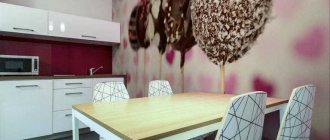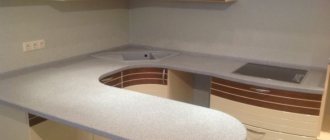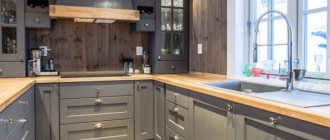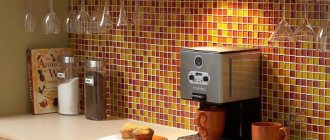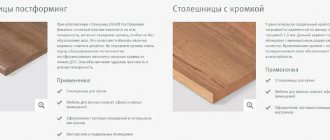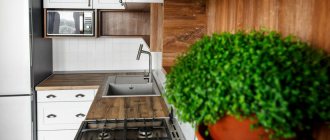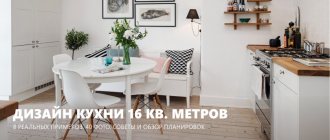The kitchen countertop is the central element of the workspace, a functional detail that plays a special decorative role and complements the interior design.
There are special requirements for materials for the manufacture of countertops related to their purpose - hot dishes are placed on the surface, there is constant exposure to moisture and chemical detergents. Aesthetic appeal and compliance with the style of the room are required.
All types of custom-made kitchen countertops must be characterized by:
- Resistant to moisture and constant exposure to temperature changes;
- Strength and durability;
- Aesthetics;
- Resistant to mechanical damage and aggressive substances;
- Maintainability;
- Hygiene;
- Stability of color and texture;
- Environmental friendliness and safety of the material used for production.
Tips for choosing the perfect countertop
- Focus on the properties of the material: different types of kitchen countertops are made of chipboard with protective coatings, natural stone, MDF, plastic - each option has advantages and disadvantages that must be taken into account.
- An important factor in the choice is the chosen interior style: there is no need to buy a luxurious countertop made of natural stone if you have a simple kitchen in the style of country, Provence or ultra-modern high-tech.
- A matte surface is more rational than a glossy one.
- The best material for a countertop in terms of hardness is stone, but dishes need to be placed on it more carefully.
- The texture of natural stone does not fit into a small kitchen - this natural material “loves” space and classic stylistic solutions.
Numerous types and colors of countertops will allow you to make the right choice specifically for your kitchen.
Laminated boards
The most common type of countertops now is laminated. They are made of chipboard or MDF coated with a layer of plastic, and are attractive with a low price and fairly good quality.
The first thing you need to pay attention to when choosing a laminated countertop is its base. Wood fiber board (MDF) is a completely safe material, but particle board (chipboard) contains resins, and some experts claim that this can emit harmful fumes.
As for the choice of coating, you should give preference to matte rather than glossy: the latter will make minor scratches more noticeable. It is better to choose a surface with a pattern: over time, small stains may appear on the tabletop, and on a plain surface they will be noticeable. And one more disadvantage of a laminated countertop is that it cannot be made seamless.
If you do not have enough one sheet to cover the entire kitchen unit, then at the joints they will have to be connected with special (usually metal) moldings. Special attention should be paid to sealing the seams and ends of the countertop, especially when installing a sink: whatever the base of the laminated countertop, it is afraid of moisture.
Types of kitchen countertops: materials and features
An important functional element for the kitchen is made of impregnated or plastic-coated chipboard, MDF panels, solid wood, natural and artificial stone. Which countertop material is best? To answer this question, pay attention to the technical features and advantages of the most popular options. The evaluation criteria are:
- Strength;
- Durability;
- Moisture resistance;
- Aesthetics;
- Heat resistance;
- Features of production and material safety;
- Price.
Taking measurements
The dimensions of the kitchen countertop are determined by the dimensions of the kitchen, the height of the person and the width of the working surface required for cooking. The length of the slab is calculated by measuring the space above the set, including all the mortise elements. The result is rounded up.
When taking measurements, the design features of the adjacent wall surfaces are taken into account and corrections are made for the result. Do not measure the countertop butt to the wall; it is better to reduce the size by 1-2 mm and cover the gap with a kitchen plinth.
Chipboard: production, characteristics and advantages
Chipboard is a material made from natural raw materials, shavings and sawdust, which are impregnated with resins. The most important factor in the popularity of the material was its low cost, availability and versatility - it is used in the manufacture of furniture, partitions and other interior elements.
The choice of material for a kitchen countertop is often opted for chipboard, precisely due to the combination of a budget price and decent technical features. It is worth paying attention to an important characteristic of particle boards: formaldehyde resins are used as a binding material. Formaldehyde is known for releasing toxic components, but chipboard manufacturers have taken care of this - only class “E1” boards are used for furniture, boards that are safe for humans. Strict standards for the production of chipboards have been developed that relate specifically to this characteristic of the boards - at the moment, all domestic companies follow strict standards.
A comparison of countertop materials allows us to highlight the following features and advantages of chipboard:
- The use of special impregnation makes it possible to ensure a sufficiently high level of surface resistance to moisture - this is achieved by using a paraffin emulsion.
- Used for the production of countertops, class “B” chipboards are characterized by high strength.
- Chipboard is easy to process - drilling, sawing.
- Aesthetics: Various finishes are available, including bright colors, imitation of natural stone and wood textures.
- Weight: Chipboard is characterized by its low weight, which simplifies the installation and delivery process.
- The surface is protected from the negative, destructive effects of acids, chemicals, high temperatures, and UV radiation.
Of all types of kitchen countertop materials, coated chipboard is called the budget version of solid wood - in terms of technical features and surface aesthetics, modern manufacturers have achieved excellent results. Thickness options are available to order: 26 and 38 mm.
Chipboard acts as a base, and the finishing is made from the following materials:
- Melamine: an inexpensive, simple option, it involves the use of special kraft paper impregnated with melamine resin. A wide variety of textures, colors and patterns, sufficient resistance to moisture. The option is not the most durable.
- Veneer: natural veneer is beautiful and stylish, fits harmoniously into classic and modern interior styles. To protect against moisture, a layer of varnish is applied. There are no comments on the aesthetic qualities of veneer - it realistically imitates natural wood, but it should be protected from damage, scratches, and chemicals.
- Steel: stainless steel is sometimes used as a finish for chipboard - this is a rare case, but it is stylish, practical, and fits perfectly into a high-tech, futuristic interior.
The last, most popular and practical type of coating is lamination using HPL plastic.
MDF
The finely dispersed fraction is obtained using the technology of forming boards from wood fibers of different densities, connected with paraffin and lignin. Lamination is carried out on all sides of the surface, and melamine or acrylic resins are used as protection, which reduces the negative impact of moisture on wood.
However, from chipboard, MDF kitchen coverings have inherited susceptibility to high temperatures, so when cooking it is better to use stands for hot containers. The softness of the material allows you to design different models and form curves, creating an unusual interior.
To purchase slabs, you don’t have to look for special manufacturing companies: Leroy Merlin kitchen countertops have an affordable price and a good assortment, they will also advise you and help you calculate the required length.
How to choose material for countertops: advantages of plastic coating
Plastic is an economical option for a budget kitchen. Chipboard with lamination has important advantages:
- Affordable cost: a beautiful and reliable countertop made of chipboard with plastic is 6-10 times cheaper than the most affordable stone model. The cost depends on the shape and dimensions of the product.
- There are an almost unlimited number of finishing options: imitation stone and wood, bright colors, printed surfaces.
- Stylistic versatility.
- Reliable and high-quality plastic is a durable, safe and hygienic material.
- The tabletop is easy to clean with special products – the plastic withstands the effects of aggressive substances.
- You can safely place hot dishes, the surface is difficult to break or scratch, and any dirt can be removed without difficulty.
Ceramics
Tile is a wonderful material for decorating a countertop, which will help create an unsurpassed rustic interior or a romantic Provencal style. The main thing is that the selected tile is processed and can withstand mechanical shocks.
It is so light that it can provide an invaluable opportunity to independently design and manufacture a kitchen from available materials, such as laminated chipboard or furniture plywood. But the money saved will go towards paying the tilers, whose work is highly valued.
What types of countertops are there?
- Glossy and matte: on a matte surface there are no greasy marks or stains; on a glossy surface any dirt is very noticeable, this also applies to scratches. Matte finish is practical and stylish, abrasions are almost invisible.
- Dark, bright and light: the most popular options are beige and gray countertops.
- Textured and monochrome without texture: the first type is less easily soiled, the texture hides scratches and abrasions.
Chipboard and plastic are materials for kitchen countertops that embody all the necessary characteristics, are affordable and look stylish in any interior.
Strained glass
Quite a rare and expensive material in our country, but very effective. Its surface can be either smooth or textured, glossy or matte, plain, colored or with an unusual print. Glass does not deteriorate from exposure to moisture, heat and fungus. It is very easy and pleasant to care for. But the fragile nature makes itself felt, so scratches and mechanical shocks are detrimental to such a tabletop - they are not masked or restored.
Types and characteristics of kitchen countertops: stone models
For a luxurious classic interior, natural colors and textures of natural materials are recommended. Types of stone for countertops include natural and artificial options. Available on the modern market:
- Models made from natural solid stone: luxurious, expensive, very heavy, installation is not easy and takes a lot of time, special care is required.
- Artificial stone: a material that has many of the advantages of natural stone, but is free of its disadvantages, and is more affordable.
- Acrylic or “liquid stone”: a practical, functional, affordable alternative to the first two options.
What types of kitchen countertops are there: acrylic models
Acrylic is a modern material with a non-porous structure, thanks to which it has its undeniable advantages:
- Resistance to moisture, temperature changes;
- The material is not afraid of mold and mildew;
- Environmental friendliness and safety: no harmful, toxic components are used as raw materials, therefore acrylic is recommended for both the kitchen and the bathroom;
- A variety of colors and textures: acrylic surface allows you to easily imitate natural stone and wood;
- Hygiene: the surface can be disinfected and washed with special products.
The most significant advantage is the ability to make a seamless structure of any shape from acrylic. Acrylic is a material for complex design solutions; the tabletop can have smooth, curved, rounded edges while maintaining solidity.
Please note: it is not recommended to place hot pots and pans on the surface, or to cut directly on the countertop.
Marble
With regard to this natural stone, we can safely say that significant shortcomings are more than compensated for by its visual appeal. It is very sensitive to moisture, hot objects and easily changes color when wine or coffee gets on the surface. At the same time, he has an attractive, noble, bewitching beauty, for which you can close your eyes to all his aristocratic whims.
Types of countertops for tables made of artificial stone
The most popular material for countertops is quartz agglomerate. The material is produced using modern equipment from raw materials of natural origin.
In many features and technical characteristics, the agglomerate is not inferior to natural stone, and the production technology makes it possible to give it all the properties important for the kitchen:
- High strength and durability: the tabletop lasts for many years, maintaining its design and properties;
- A wide variety of colors and patterns - you can choose the appropriate option for your kitchen;
- Moisture resistance, resistance to chemicals, high temperature;
- Simple and affordable care;
- The surface is characterized by resistance to scratches and mechanical damage;
- Agglomerate is an environmentally friendly, non-toxic, hygienic material.
Quartz agglomerate embodies functionality, practicality and aesthetic perfection.
The various types and materials of countertops presented on the site will help you choose and order the option that best suits you. The company will implement the project in the required dimensions and will carry out delivery and installation.
Agglomerate
Quartzite surfaces are created on the basis of granite, marble or quartz chips pressed in the presence of epoxy resins under high pressure.
As a result of production, the finished material is not inferior in strength characteristics and weight of the structure to natural stone. A significant disadvantage of the coating is the impossibility of seamless installation (butt laying is used).
